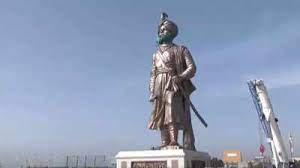Statue Of Prosperity : Statue Of Nadaprabhu Kempegowda

The Prime Minister of India unveiled a 108-foot statue of Nadaprabhu Kempegowda and inaugurated Terminal 2 of Bengaluru airport, which is named after the 16th-century figure credited with founding the city.
- The status is called the “Statue of Prosperity”.
- As per the ‘World Book of Records’, it is the first and the tallest bronze statue of a founder of a city.
- Renowned sculptor and Padma Bhushan awardee Ram Vanji Sutar has designed the statue.
- Sutar had built the ‘Statue of Unity’ in Gujarat and the statue of Mahatma Gandhi in Bengaluru’s ‘Vidhana Soudha’.
- As a precursor to the unveiling, ‘Mruthike’ (sacred mud) was collected from over 22,000 locations across the state, which was mixed symbolically with the mud beneath one of the four towers of the statue.
Nadaprabhu Kempegowda:
- He was born in 1513 in a village near Yelahanka.
- He was the chieftain under the Vijayanagara Empire of the 16th century.
- He is an iconic figure among Vokkaligas, Karnataka’s second most dominant community after Lingayats.
- He studied for nine years in a GuruKula near Aigondapura (present day Hessaraghatta) where he learnt statecraft and martial skills.
- He is widely acknowledged as the founder of Bengaluru, Karnataka.
- It is said that he conceived the idea of a new city while hunting with his minister, and later marked its territory by erecting towers in four corners of the proposed city.
- He is also credited with having developed around 1,000 lakes in the city to cater to its drinking and agricultural needs.
- Kempegowda has been credited for abolishing the practice of cutting the fingers of the left hand of an unmarried woman during a custom known as ‘Bandi Devaru’, an important custom of Morasu Vokkaligas.
- He died in 1569, having ruled for about 56 years.




